
Our star magnolia has finally come back to life! I can’t even begin to tell you how much the sight cheered me up — even after more than a decade and a half in the Pacific Northwest, my native Californian synapses droop drastically during the long, gray winters here. So hooray for an early spring-blooming tree that goes from dead-looking to beflowered in three days flat.
Speaking of lengthy periods of anticipation, way back in early February, eagle-eyed reader Kim pointed out a fairly extensive omission in my twice-yearly examinations of standard format for manuscripts: although I have been providing illustrations of same for several years now, I’d never shown the innards of a properly-formatted book proposal. In fact, as Kim explained,
Anne — Thank you for this glorious blog. It is a wealth of information. I am putting together a submissions package (requested materials, yea!), which includes a book proposal. After searching through your site, I still can’t find a specific format for the thing. For example, should the chapter summaries be outlined? double-spaced? Should I start a new page for each subheading? Also, my book has several very short chapters (80 in total). Should I group some of them together in the summaries, lest it run too long? Or is it better to give a one sentence description of each? Thanks again.
My first response to this thoughtful set of observations, I must admit, was to say, “No way!” After all, I had done a fairly extensive series entitled HOW TO WRITE A BOOK PROPOSAL (beginning here) as recently as…wait, does that say August of 2005?
As in within a month of when I started this blog? More to the point, since before I sold my second nonfiction book to a publisher? (No, you haven’t missed any big announcements, long-time readers: that one isn’t out yet, either.)
Clearly, I have a bit of catching up to do. Equally clearly, I am deeply indebted to my intrepid readers for telling me when they cannot find answers to their burning questions in the hugely extensive Author! Author! archives.
In the interests of responding to Kim’s quite legitimate concerns, let’s continue the page-level look at a professional book proposal we began yesterday. Rather than assume, as I apparently have for the last four and a half years, that merely saying that book proposals should be in standard manuscript format (with certain minimal exceptions), let’s see what that might look like in action. In fact, since I’ve been going over the constituent parts in order, let’s go ahead recap from the beginning, talking a little about what purpose each portion of it serves.
Here, ladies and gentlemen of the Author! Author! community, are the building blocks of a professional book proposal, illustrated for your pleasure. As you will see, much of it is identical in presentation to a manuscript.
1. The title page
Like any other submission to an agent or editor, a book proposal should have a title page. Why? To make it easier to contact you — or your agent — and buy the book, of course.
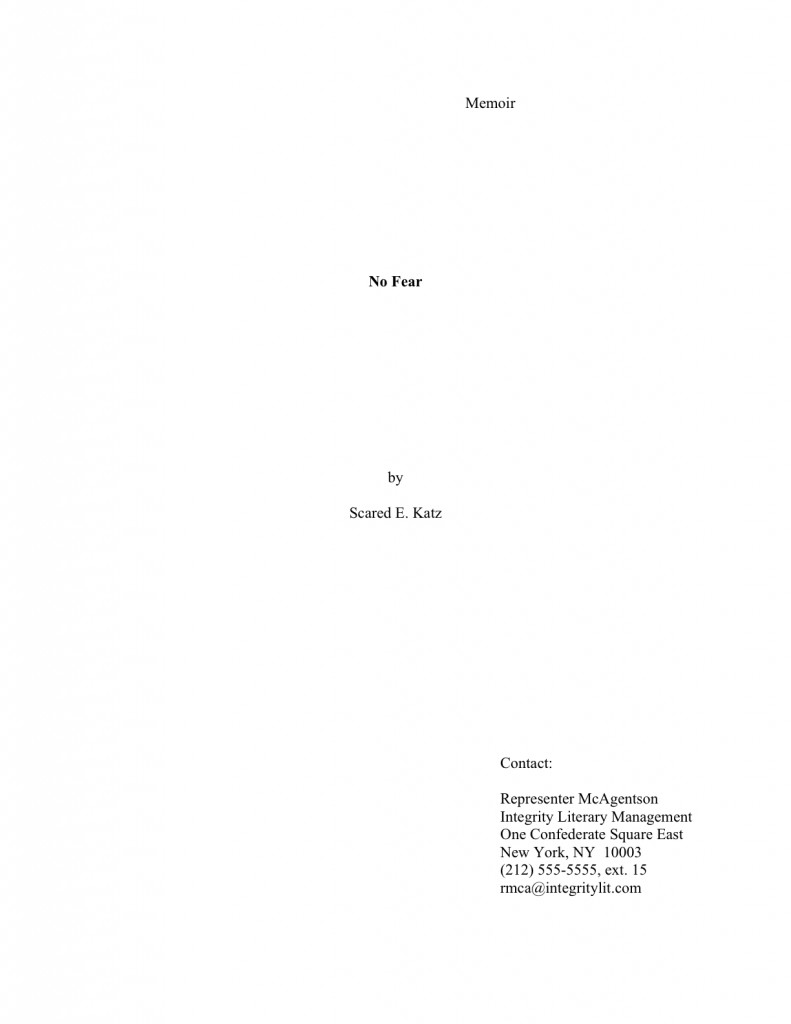
2. The overview
First-time proposers often shirk on this part, assuming — usually wrongly — that all that’s required to propose a nonfiction book is to provide a 4-6 page synopsis of it. In practice, however, a successful overview serves a wide variety of purposes:
(a) It tells the agent or editor what the proposed book will be about, and why you are the single best person on earth to write about it. (Pretty much everyone gets that first part, but presenting one’s platform credibly is often overlooked in an overview. If an agent or editor makes it to the bottom of page 3 of your proposal without understanding why you are a credible narrator for this topic, your proposal is going to fall flat.)
(b) It presents the central question or problem of the book, explaining why the topic is important and to whom. (Amplifying on the argument in (a), couching it in larger terms and trends. Or, to put it another way: why will the world be a better place if this book is published?)
(c) It demonstrates why this book is needed now, as opposed to any other time in literary history.
(d) It answers the burning question: who is the target audience for this book, anyway? (To reframe the question as Millicent’s boss will: how big is the intended market for this book, and how do we know that they’re ready to buy a book on this subject?)
(e) It explains why this book will appeal to the target audience as no book currently on the market will. (In other words, how are potential readers’ needs not being served by what’s already on the market, and why will your book serve those needs in a better, or at any rate different, manner?)
(f) It shows how your platform will enable you to reach this target audience better than anyone else who might conceivably write this book. (Tying together all of the foregoing, adding your platform, and stirring.)
(g) It makes abundantly clear the fact that you can write. (Because lest we forget, a book proposal is a job application at base: the writer’s primary goal is to get an agent or editor to believe that she is the right person to hire to write the book she’s proposing.)
In the interest of establishing points (a), (b), and (g) right off the bat, I like to open a book proposal with an illustrative anecdote or direct personal appeal that thrusts the reader right smack into the middle of the central problem of the piece, reducing it to an individual human level. Basically, the point here is to answer the question why would a reader care about this? within the first few lines of the proposal, all the while showing off the writer’s best prose.
For a general nonfiction book — particularly one on a subject that Millicent might at first glance assume to be dry — this is a great opportunity for the writer to give a very concrete impression of why a reader might care very deeply about the issue at hand. Often, the pros open such an anecdote with a rhetorical question.
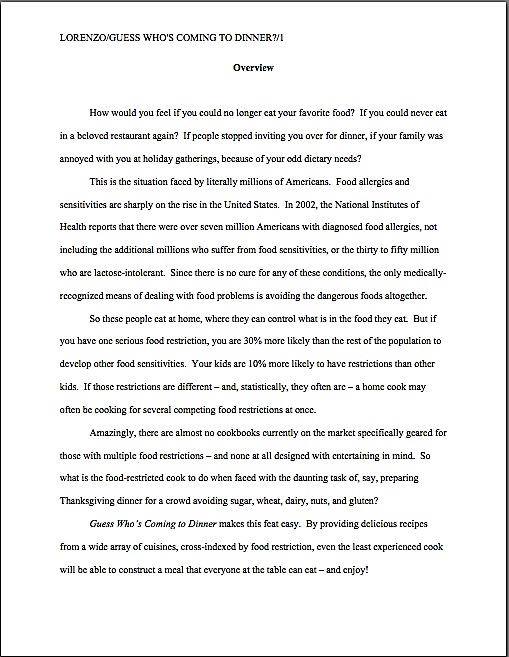
The opening anecdote gambit works especially well for a memoir proposal, establishing both the voice and that the memoir’s central figure is an interesting person in an interesting situation. While it’s best to keep the anecdote brief — say, anywhere between a paragraph and a page and a half — it’s crucial to grab Millicent’s attention with vividly-drawn details and surprising turns of event. To revisit our example from yesterday:
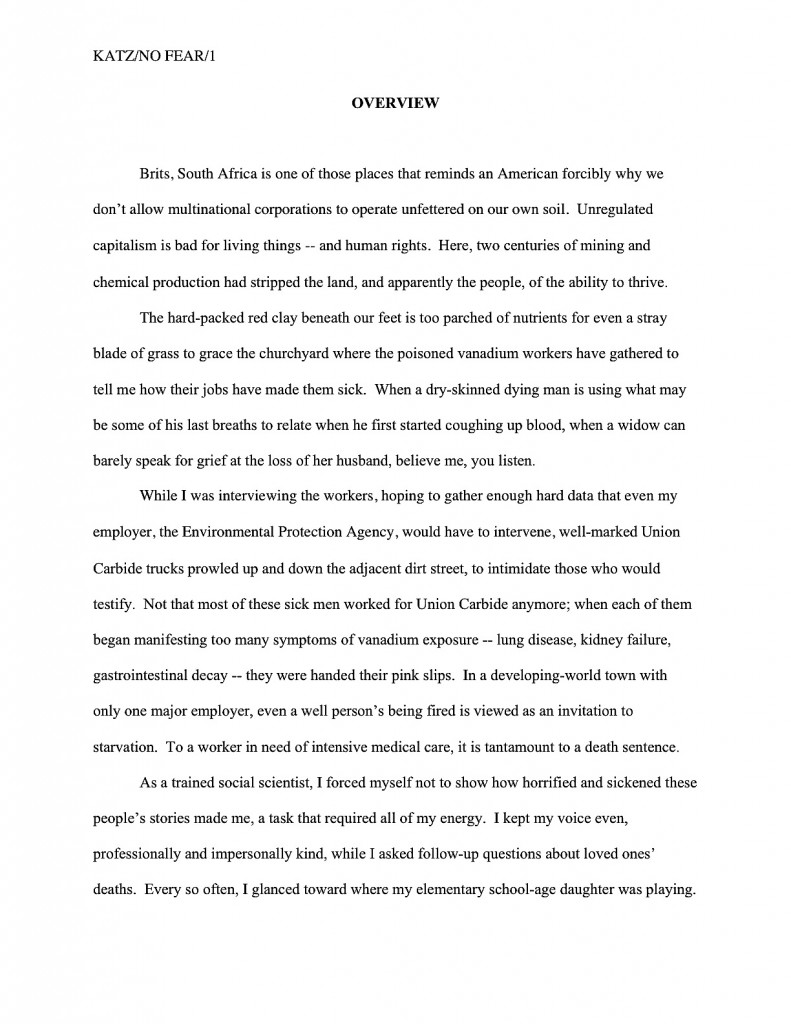
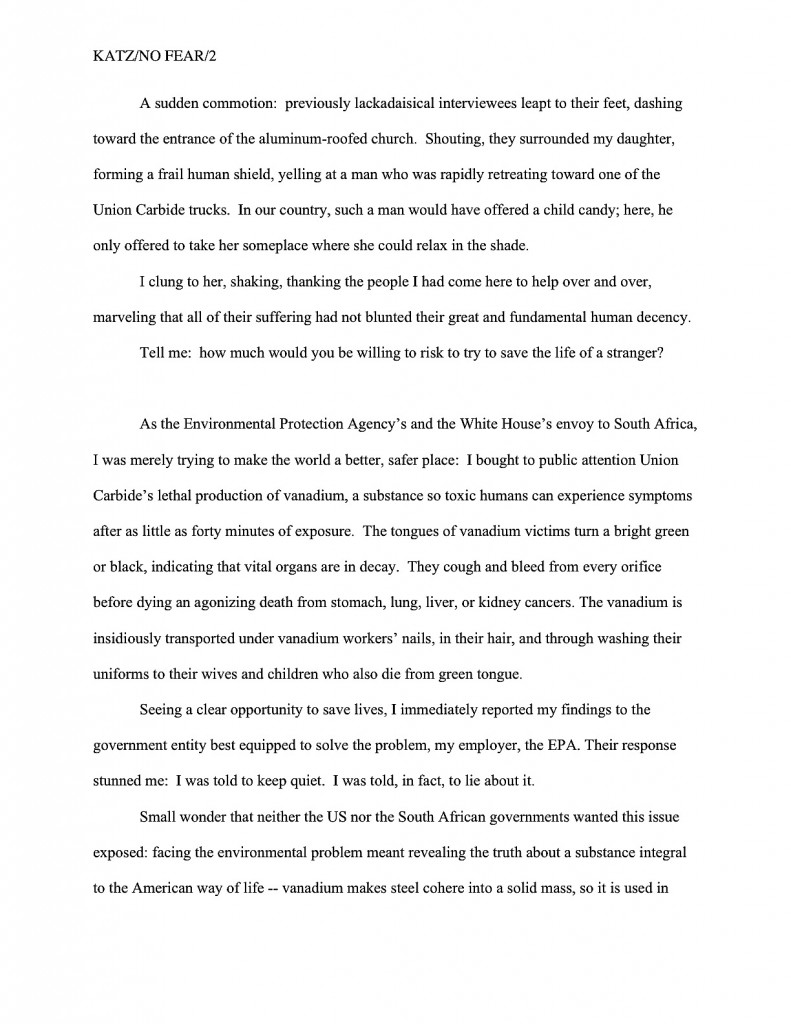
As we saw in that last example, you can move from the anecdote or opening appeal without fanfare, simply by inserting a section break (in other words, by skipping a line). While many book proposals continue this practice throughout the overview, it’s a good idea to mark its more important sections with subheadings, like so:
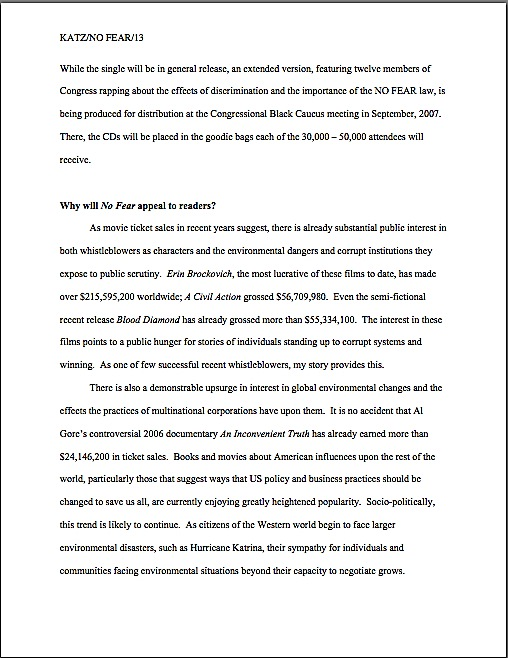
As you may see, incorporating subheadings, while not strictly speaking necessary, renders it very, very easy for Millicent to find the answers to the basic questions any book proposal must answer. If the text of the proposal can address those questions in a businesslike tone that’s also indicative of the intended voice of the proposed book, so much the better.
Please note, however, that I said businesslike, not in business format: under no circumstances should a book proposal either be single-spaced or present non-indented paragraphs.
This one confuses a lot of first-time proposers, I’ve noticed. “But Anne!” they protest, and not entirely without justification. “A book proposal is a business document, isn’t it? Doesn’t that mean that it should be in business format?”
The short answer is no. The not-so-short answer is: not if you want Millicent to read it. To the fine folks in the publishing industry, a writer who does not indent her paragraphs is presumed illiterate.
Long-time readers, chant it with me now: the publishing industry does not use business format, even in its business letters; always, always, ALWAYS indent your paragraphs.
3. The competitive market analysis
The competitive market analysis is probably the most widely misunderstood portion of the book proposal. What the pros expect to see here is a brief examination of similar books that have come out within the last five years, accompanied by an explanation of how the book being proposed will serve the shared target audience’s needs in a different and/or better manner. Not intended to be an exhaustive list, the competitive market analysis uses the publishing successes of similar books in order to make a case that there is a demonstrable already-existing audience for this book.
But that’s probably not how you’ve heard this section described, is it? Let me take a stab at what most of you have probably heard: it’s a list of 6-12 similar books. Period. The result usually looks like this:
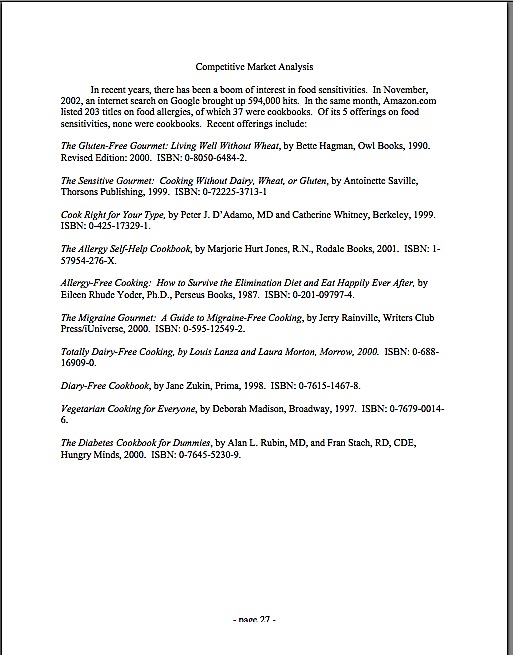
Makes it pretty plain that the writer thinks all that’s required here is proof that there actually have been other books published on the subject, doesn’t it? Unfortunately, to Millicent’s critical eye, this doesn’t just seem like ignorance of the goal of the competitive market analysis — it appears to be proof positive of the authorial laziness of a writer who hasn’t bothered to learn much about either how books are proposed or the current market for the book he’s proposing.
To be fair, this is the section where first-time proposers are most likely to skimp on the effort. Never a good idea, but a particularly poor tactic here. After all of these years, the average Millicent is awfully darned tired of proposers missing the point of this section — and it’s hard to blame her for being miffed, considering how often first-time proposers assume that it has no point, other than to create busywork. As you may see above, the bare-bones competitive market analysis makes the writer seem as if he’s gone out of his way to demonstrate just how stupid he thinks this particular exercise is.
That’s because he’s missed the point of the exercise. The goal here is not merely to show that other books exist, but that the book being proposed shares salient traits with books that readers are already buying. And because the publishing industry’s conception of the current market is not identical to what is actually on bookstore shelves at the moment, the savvy proposer includes in his competitive market analysis only books that have been released by major houses within the last five years.
That last point made some of you choke on your tea, didn’t it? Don’t you wish someone had mentioned that little tidbit to you before the first time you proposed?
Even when proposers do take the time to research and present the appropriate titles, a handful of other mistakes tend to mark the rookie’s proposal for Millicent. Rather than show you each of them individually, here’s an example that includes several. Take out your magnifying glass and see how many you can catch.

How did you do?
Let’s take the more straightforward, cosmetic problems first, the ones that would immediately leap out at anyone familiar with standard format. There’s no slug line, for starters: if this page fell out of the proposal — as it might; remember, proposals are unbound — Millicent would have no idea to which of the 17 proposals currently on her desk it belonged. It does contain a page number, but an unprofessionally-presented one, lingering at the bottom of the page with, heaven help us, dashes on either side.
Then, too, one of the titles is underlined, rather than italicized, demonstrating formatting inconsistency, and not all of the numbers under 100 are written out in full. Not to mention the fact that it’s single-spaced!
All of this is just going to look tacky to Millie, right?
Okay, what else? Obviously, this version is still presented as a list, albeit one that includes some actual analysis of the works in question; it should be in narrative form. Also, it includes the ISBN numbers, which to many Millicent implies — outrageously! — a writerly expectation that she’s going to take the time to look up the sales records on all of these books.
I can tell you now: it’s not gonna happen. If a particular book was a runaway bestseller, the analysis should have mentioned that salient fact.
There’s one other, subtler problem with this example — did you catch it?
I wouldn’t be astonished if you hadn’t; many a pro falls into this particular trap. Let’s take a peek at this same set of information, presented as it should be, to see if the problem jumps out at you by contrast.

Any guesses? How about the fact that the last example’s criticism is much, much gentler than the one before it?
Much too frequently, those new to proposing books will assume, wrongly, that their job in the competitive market analysis is to make the case that every other book currently available has no redeeming features, as a means of making their own book concepts look better by contrast. Strategically, this is almost always a mistake. Anybody out there have any ideas why?
If it occurred to you that perhaps, just perhaps, the editors, or even the agents, who handled the books mentioned might conceivably end up reading this book proposal, give yourself three gold stars. It’s likely, isn’t it? After all, agents and editors both tend to specialize; do you honestly want the guy who edited the book you trashed to know that you thought it was terrible?
Let me answer that one for you: no, you do not. Nor do you want to insult that author’s agent. Trust me on this one.
No need to go overboard and imply that a book you hated was the best thing you’ve ever read, of course — the point here is to show how your book will be different and better, so you will need some basis for comparison. Just don’t go overboard and use phrases like terrible, awful, or an unforgivable waste of good paper, okay?
I had hoped to get a little farther in the proposal today — at least farther than we got yesterday — but as I’m already running long, I’m going to sign off for the day. But since you’re all doing so well, here’s one final pop quiz before I go: what lingering problem remains in this last version, something that might give even an interested Millicent pause in approving this proposal?
If you immediately leapt to your feet, shouting, “I know! I know! Most of these books came out more than five years ago, and of those, The Gluten-Free Gourmet is the only one that might be well enough known to justify including otherwise,” give yourself seven gold stars for the day.
Heck, take the rest of the day off; I am. Keep up the good work!